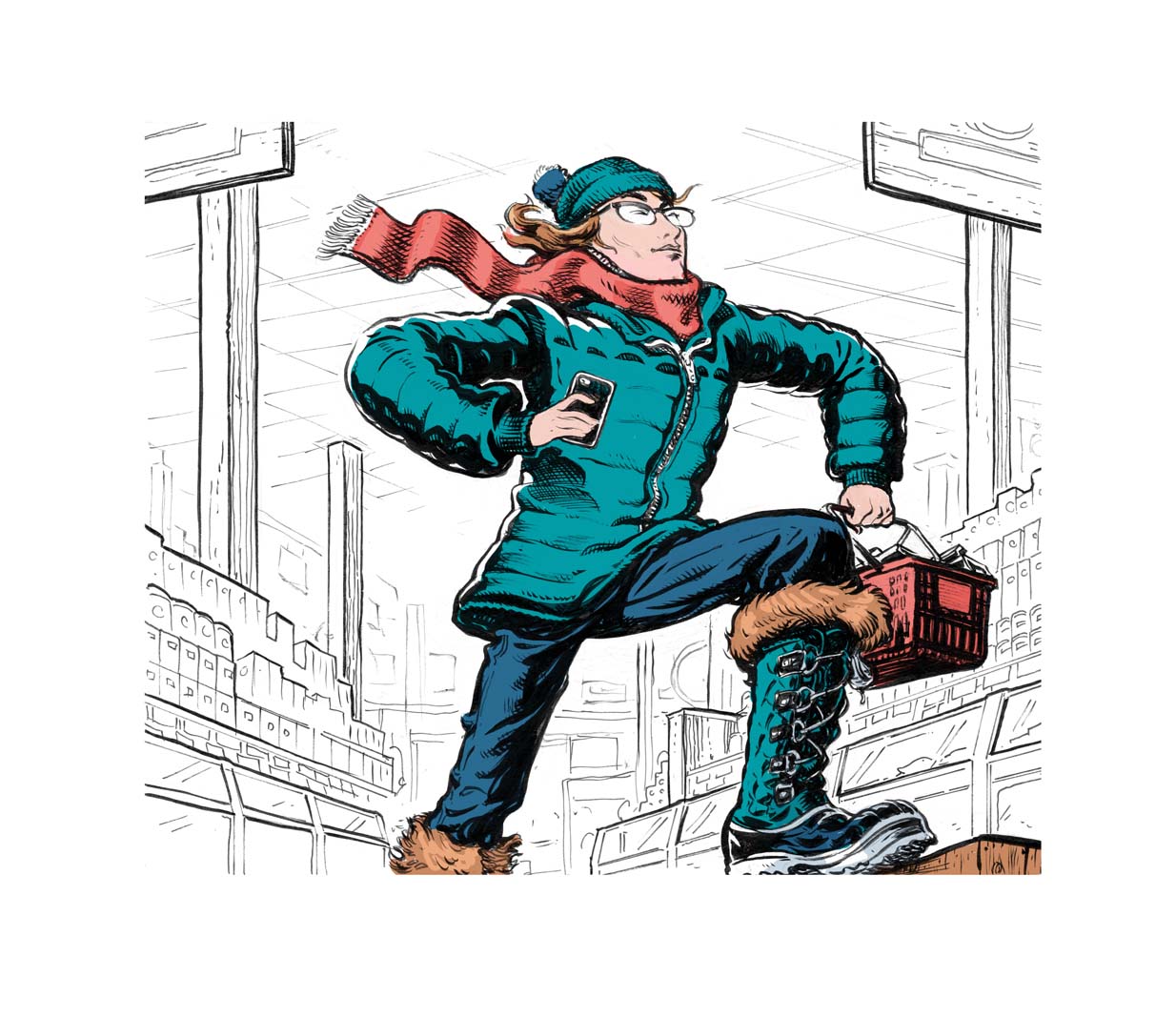
illustration by lars leetaru
In my youth, I spent frigid midwinter nights shivering in a thin sweatshirt and canvas Chuck Taylors outside First Avenue. Since then, my cold-weather preparations have vastly improved. I rock my knee-high Sorels, and I’m cautiously exploring the technological winter wonders of our futuristic present.
One stretch of Hennepin Avenue in Uptown, which was filled with live music and people smoking cigarettes in my Chuck Taylors days, is now an optimal grouping of shops to find a new winter jacket. Just south of Lake Street, the storefronts feel like a low-elevation base camp where adventurers can gather high-tech gear necessary to scale Mount Everest.
Recently, I inspected the $800 North Face Cryos Expedition Gore-Tex Parka—“cryos” in Greek means “icy cold”—which looked like something you’d want on your back if hell actually froze over, or if your sled dogs abandoned you on a glacier. Next door at Columbia, a parka came equipped with an Alpine helmet-compatible, baffled hood. Confused, I snuck into the dressing room to Google “baffled hood” (puffy coats’ baffles hold insulation in place) and “Alpine helmet” (they protect skiiers’ noggins).
When asked to describe the winter terrain I most often traversed, I guiltily admitted, “the path around Lake Harriet,” “Lake Superior beaches,” “Trader Joe’s frozen food aisle,” and, I added, “occasionally Mount Kilimanjaro.”
Another advance for winterizing is an increasing number of phone apps that reduce seasonal tasks to a couple taps and swipes on the screen. First things first: Rake and bag leaves before the first snow. For a digital alternative to DIY or the neighbor kid, the Leavz app charges upwards of $190 to rake, bag, and clear a small yard.
When snow hits, remember that most Minnesota cities have an ordinance that requires citizenry to clear their sidewalks within 24 hours of snowfall. Unfortunately, many of our snow-clearing devices harken back to the Stone Age, like the shovel—a tool first fashioned from oxen scapula. Do you really want to rise at dawn to drag around a Neolithic implement, hoisting hundreds of pounds of frozen water and throwing it into piles?
Recent apps like Plowz and SnoHub offer ways to find someone else to snowblow your driveway, even if it’s 4 a.m. and your neighbors’ kids have left for college. On Tinder you might list your height, whereas on Plowz you divulge the length of your driveway and the depth of the snow. Local contractors arrive by the end of the day, do the job, and forfeit a healthy chunk of their profit back to company HQ. Minutes later, an image of your clean driveway arrives by text—the way an assassin-for-hire might send photographic proof of a successful hit.
For general winter problems, such as de-icing sidewalks, you can hire someone through TaskRabbit.com. However, I’ve lucked upon a handywoman with no online presence. Mila fixes anything with minimal tools and seems to operate on a strictly word-of-mouth basis, much like Harvey Keitel’s Pulp Fiction fixer character, The Wolf.
Mila is definitely the person I would call on the off chance I did something truly stupid, like get myself stuck on a weathervane while trying to shovel snow off the roof. She arrives promptly, and she’s nonjudgmental—although her half-raised eyebrow indicates she’s aware that I’m an amateur at most survival-oriented tasks, like keeping the roof from collapsing.
Even with tech advances that make winter more palatable, I wouldn’t trade these moments with Mila for anything. Also, if I get stuck in ski pants two sizes too small, would I want a stranger from the internet to come and chop me out? I know Mila will be there for me, ready with the miniature axe tool on what used to pass as a wow-inducing gadget, her Swiss Army knife.







